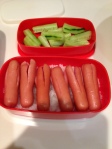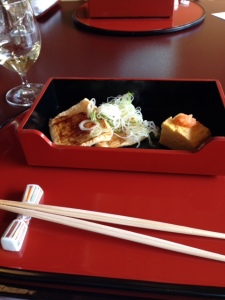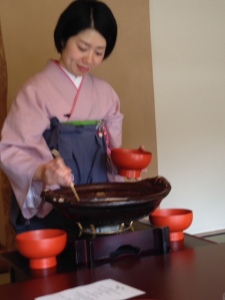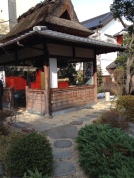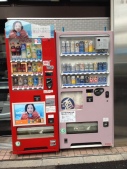 One of the best things that going through cancer treatment has taught me is to be still. Maybe that sounds a little crazy – who doesn’t know how to sit still? But I didn’t.
One of the best things that going through cancer treatment has taught me is to be still. Maybe that sounds a little crazy – who doesn’t know how to sit still? But I didn’t.
In my real life, I didn’t really know how to be still. Day after day I would run around town, doing errands, taking my kids places, working, doing volunteer work, and keeping busy. If I wasn’t busy, I felt this guilty nudge like I should be doing something productive. I would go out with friends for lunch, go out for fancy dinners with my husband and other couples, and all the while, my brain would be running with my to-do list and other items I had to remember.
In June, however, everything came to a screeching halt with the cancer diagnosis. I was sicker than I had ever been in my life; hopefully sicker than I’ll ever be again. I couldn’t focus on getting myself out of a chair without outside help, much less a to-do list. During that time, when I was at my sickest, I didn’t care about productivity and I had to learn to ask for help, and my friends and family really pitched in.
In May, while still in Japan, I took a first step toward stillness and tried Zazen Mediation, but nothing could have prepared me for this. Just getting the chemotherapy required me to sit in a chair for upwards of six hours at a stretch. My utter lack of mobility in the days following treatment demanded that I sit in front of the television for hours on end. In fact, my brain power was so low at certain points, that I had to watch re-runs. I couldn’t even watch first-run shows because I couldn’t understand or remember the plots! This was a totally new experience for me – my brain wouldn’t perform the necessary functions to deal with real life.
In August, at the recommendation of my cousin Anna, I tried Reiki treatment. I had always had such good luck with acupuncture, but Anna, a Bikram Yoga instructor, reminded me that I was already receiving a lot of invasive treatment and perhaps something less intrusive to my body might be in order. Anna found a Reiki practitioner for me right in my neighborhood in Maryland.
Reiki is a Japanese healing art, developed in 1922 by Buddhist Monk Mikao Usui. The main idea is that the practitioner lays his or her hands on the patient and believes that energy in the form of Ki is being transferred from the hands to the body underneath, which encourages healing and balance. In Japan, the practice is more common and accepted as a healing art. Here in the U.S. Reiki is seen as an alternative health option, best used in concert with Western medicine. My friend Kendra, however, reminds me that my oncologist’s job is to get rid of my cancer; my job is to take care of myself and my body while in treatment. Reiki is one way that I have learned to relax.
The practitioner I found, Naning, is an Indonesian woman, who has lived in the U.S. for decades. Ironically, I learned upon first meeting her, that she had also lived in Japan for a number of years as a teenager, and attended the International School of the Sacred Heart, located not far from my Tokyo apartment. We had a lot in common immediately and I felt comfortable. She has not only practiced Reiki at home for years, but she also works with doctors and nurses at local hospitals, giving them Reiki treatments to improve the care they give their patients. The literature she gave me discusses the healing benefits of Reiki practice for patients and practitioners alike. She also gave me a card with the five precepts of Reiki on it:
At least for today:
- Do not be angry,
- Do not worry,
- Be grateful,
- Work with diligence,
- Be kind to people.
I still look at it every day – so I can think and remember and act in a mindful way.
Naning led me upstairs to the dedicated Reiki room in her home. The entire room is done in white and cream colors, with blinds over the window to allow only soft light to come into it. At the center of the room is a traditional massage table, which she drapes with colorful and silky Indonesian cloths. Naning invited me to lie on my back that first time, and from the very first second I put my head on the small pillow she placed under my neck, I felt myself letting go. She put a pillow under my knees to increase my comfort and we got started.
With Naning, I did something that I haven’t done with anyone else – and I mean anyone, even my husband. I took off my head scarf so I was completely bald. I wanted her to see me completely and participate fully in my own wellness. She washed her hands, murmured a prayer, and put her hands on my forehead. The relief was immediate. Her palms warmed against me. She touched my head, my cheeks and even my nose initially.
Her hands sort of naturally settled at the sides of my head, on my temples and she rested them there. She had a little timer that chimed every five or so minutes and she moved her hands to a different part of my body. She concentrated a lot on my head and face, but she also touched my arms, my stomach and parts of my legs too. Then I turned on my stomach and she put her hands on my back in various places.
It wasn’t like a massage; her hands were mostly warm and unmoving. But for some reason my mind was completely still. I’ve had it done a number of times, and it makes every single thought go out of my head. I am only aware of my body, my breath, and Naning’s hands. When the little chime rings and she moves her hands, I actually feel something move inside me. I can feel the energy; I can feel the warmth.
The effects from the Reiki last for days. I feel calmer; my side-effects ease; and it’s easier for me to concentrate on something if I have to.
I will always be grateful to Naning for showing me how it really looks to have a still mind. I had never experienced it before. I hope that I can carry this feeling back into my “real” life as my health hopefully returns. This ability to focus inward for even a moment allows me to be centered and then re-focus on the parts of my outer life that need attention. It’s a gift – and another one of those silver linings of cancer.
 Just this week the 2015 Michelin Guide came out and The Japan Times reports that Tokyo has retained its spot as the best city in the world in which to eat. But back in September, Marc and I celebrated our 20th wedding anniversary, and in lieu of presents, we decided to go experiential, and we made reservations at a restaurant called Kanda. In the new guide, Kanda is listed as #4 on the list of the twelve best restaurants in Tokyo. It deserves the rank; it was a food experience like no other I’ve had.
Just this week the 2015 Michelin Guide came out and The Japan Times reports that Tokyo has retained its spot as the best city in the world in which to eat. But back in September, Marc and I celebrated our 20th wedding anniversary, and in lieu of presents, we decided to go experiential, and we made reservations at a restaurant called Kanda. In the new guide, Kanda is listed as #4 on the list of the twelve best restaurants in Tokyo. It deserves the rank; it was a food experience like no other I’ve had. bottom floor of an apartment building and the sign is out of the way and very unobtrusive. It is only in Japanese. If you were not looking for it, you’d never find it. I did not take photos of the sign, the door or the restaurant in general because they only allow pictures of the actual food. The restaurant is small and spare, but elegantly decorated. There is one table in a side room behind a curtain that seats about eight, but the main dining room consists of twelve seats at a bar. It is done in light wood with bamboo-backed chairs. The walls have a few small paintings and Japanese sayings in Kanji adorning them, but otherwise the focus really is meant to be on the food, not the place itself.
bottom floor of an apartment building and the sign is out of the way and very unobtrusive. It is only in Japanese. If you were not looking for it, you’d never find it. I did not take photos of the sign, the door or the restaurant in general because they only allow pictures of the actual food. The restaurant is small and spare, but elegantly decorated. There is one table in a side room behind a curtain that seats about eight, but the main dining room consists of twelve seats at a bar. It is done in light wood with bamboo-backed chairs. The walls have a few small paintings and Japanese sayings in Kanji adorning them, but otherwise the focus really is meant to be on the food, not the place itself.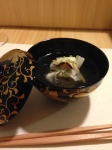




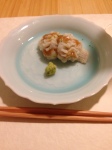

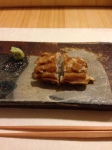



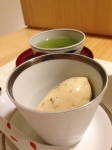


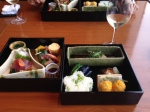


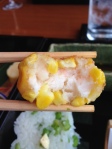


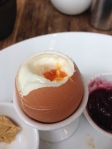

 arrangements, gilt elevators and omnipresent staff. The elevators themselves are perfectly modern but they have beautful touches of bygone eras. Chief among those touches is the concept of the elevator girl. She is immaculately dressed in a uniform complete with the pillbox hat. She has to manually close the bars before the official elevator door will close. She uses a lever to stop and start the elevator. She steps out on the floors to announce where the elevator is and where it is headed, along with what is located on that particular floor. It is truly a gorgeous throwback and a sight to behold. I highly recommend a trip to Takashimaya’s flagship store in Nihonbashi – go ride the elevator.
arrangements, gilt elevators and omnipresent staff. The elevators themselves are perfectly modern but they have beautful touches of bygone eras. Chief among those touches is the concept of the elevator girl. She is immaculately dressed in a uniform complete with the pillbox hat. She has to manually close the bars before the official elevator door will close. She uses a lever to stop and start the elevator. She steps out on the floors to announce where the elevator is and where it is headed, along with what is located on that particular floor. It is truly a gorgeous throwback and a sight to behold. I highly recommend a trip to Takashimaya’s flagship store in Nihonbashi – go ride the elevator.







